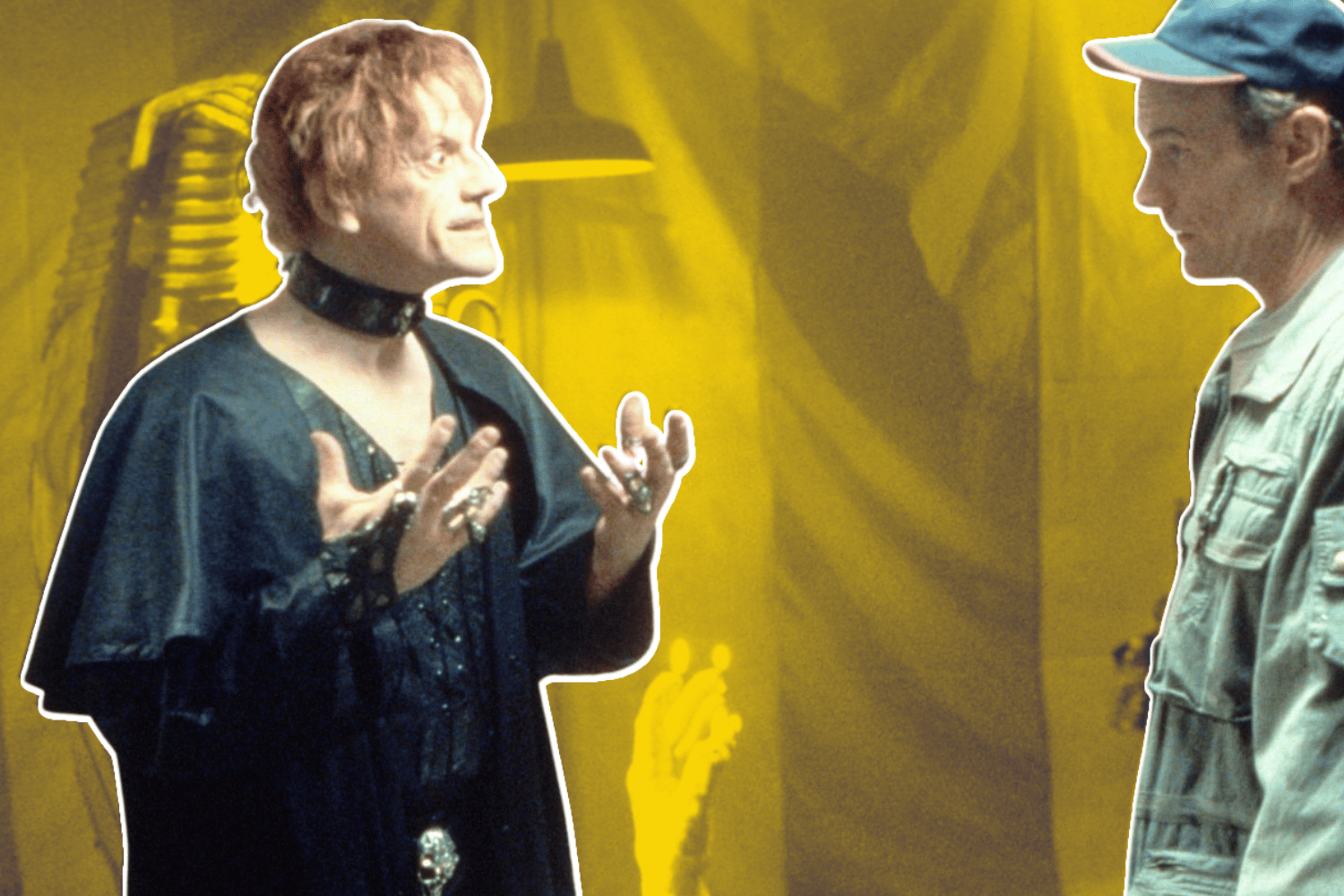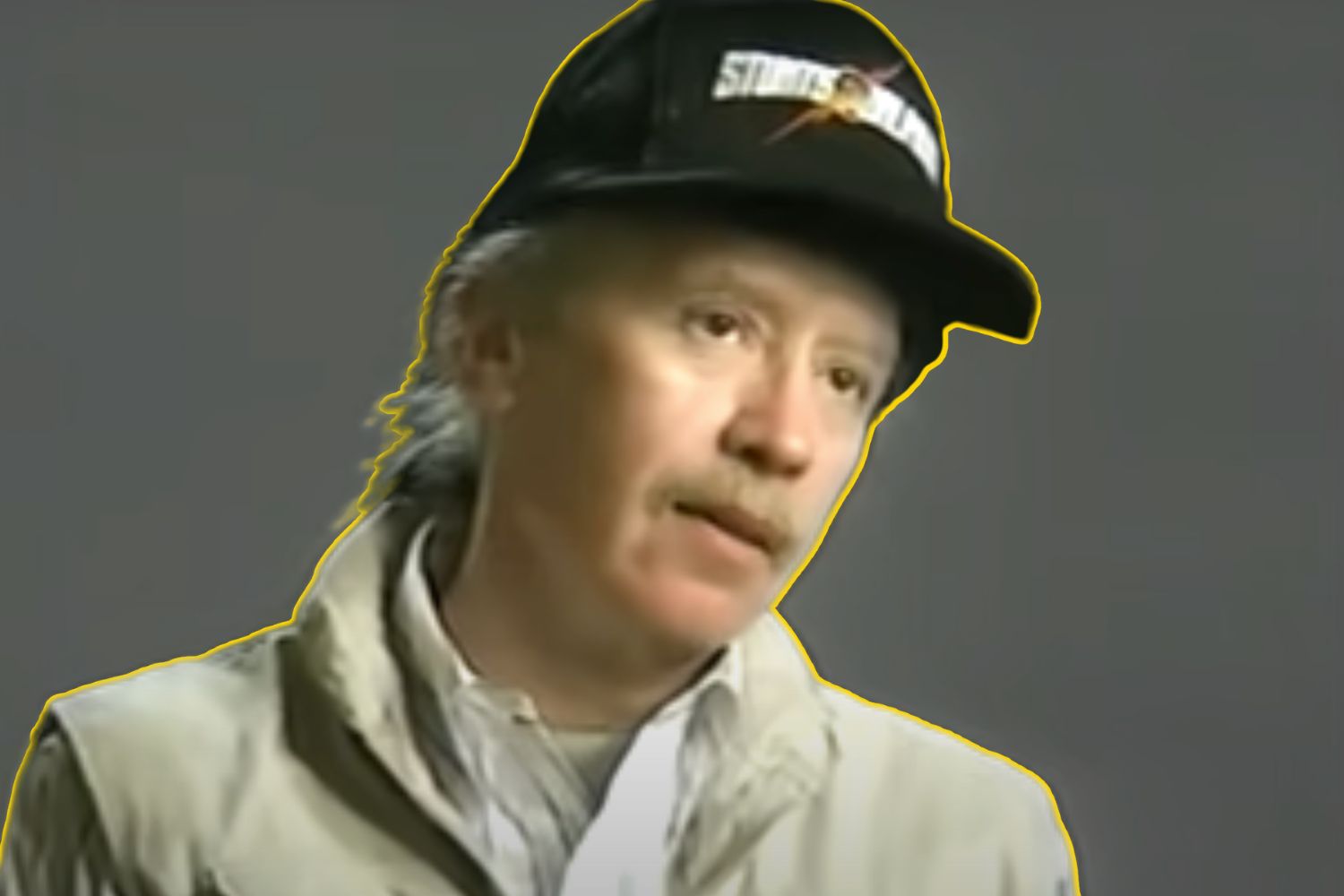Editorials
Two Titans at a Carnival: ‘Quicksilver Highway’ Takes Viewers on a Curious Journey
January 18th, 2023 | By Samantha Jacobs

Stephen King and Clive Barker conquered the horror genre independently, but one 1997 omnibus film sought to combine their visions. Quicksilver Highway is a made-for-TV double-feature that highlights two lesser-known stories by the literary titans. In an era when many horror fans got their fix via Tales From The Crypt, this anthology had an opportunity to use its format to compare King and Barker’s styles. However, whether or not it succeeded in this aim is debatable.
Quicksilver Highway isn’t a scary movie in the traditional sense. There are no jump scares, boogeymen, or deep psychological terrors. Instead, the film is a campy horror-comedy that made body horror more accessible to television audiences. Like many anthologies, the film uses a framing device to connect the two stories. That framing device is Aaron Quicksilver (Christopher Llyod), a traveling carnival worker who looks like a poster child for the 90s goth aesthetic. The mysterious performer tells the stories as cautionary tales to people he encounters in his travels.
The first short film adapts Stephen King’s Chattery Teeth. King published this story in 1992, and Quicksilver Highway is its only film adaptation. The framing device sets up the story by introducing Aaron Quicksilver to a young bride on the highway. When they meet, the bride is waiting for her husband to return to their broken-down car. While the bride’s husband searches for repair help, Quicksilver relays the story of traveling salesperson Bill Hogan (Raphael Sbarge).
At a roadside store in the middle of nowhere, Hogan spots a set of wind-up chattering teeth. Although the teeth are inoperable, Hogan finds them strangely charming. The shopkeep gives him the teeth, and Hogan drives into an impending dust storm with his new treasure.
Fatefully, Hogan also picks up a hitchhiker.
Things seem copacetic at first, but the hitchhiker is a vicious killer who fights Hogan for control of his van. After a near-fatal crash, Hogan ends up trapped in his seatbelt while his murderous passenger plots his death. However, the chattering teeth miraculously come to life and save Hogan just in time. This bizarre children’s toy is evil in its own way, but the film demonstrates that enemies are sometimes friends in disguise.
The anthology uses a subtle trick to tie its framing device into this cautionary tale, and audiences might miss it if they aren’t watching closely. The same actor plays Bill Hogan and the bride’s husband, Kerry. When Quicksilver finishes telling the story, Kerry’s abandoned bride discovers he’s been the victim of a car accident. Then, in a weird but funny moment, audiences see the teeth dragging Kerry’s lifeless body off the highway. Given the teeth’s apparent ability to sense evil, it appears the bride wasn’t bound for marital bliss after all.
The second short film adapts Clive Barker’s The Body Politic. While Chattery Teeth highlights an unexpected hero, this story turns something innocuous into something horrific. Clive Barker’s best-known works typically focus on fantastical creatures symbolizing specific characteristics of humanity. However, The Body Politic takes his penchant for disturbia to a new level. Instead of otherworldly beasts, the inhabitants of this tale are beset by their own hands — literally. But first, the film takes Aaron Quicksilver to the setting he knows best: a carnival tent. When a pickpocket wanders into his tent, Quicksilver takes the opportunity to tell him this tale.
The story begins with Dr. Charles George (Matt Frewer), a plastic surgeon whose hands fail him during a procedure. Although the surgery doesn’t go as planned, fans may notice a brief but memorable cameo from Clive Barker himself. Barker plays an anesthesiologist who narrowly misses a flying scalpel thrown by Dr. George’s rogue hands. Afterwards, Barker’s character removes his mask, grins at the camera, and says: “What have I ever done to you?”
Dr. George assumes this mishap is a one-time issue, but things quickly spiral out of control as his hands take on lives of their own. Whereas King’s chattering teeth are a voiceless entity, the doctor’s hands have distinct personalities. While Dr. George sleeps, “Left” and “Right” plot their escape from his body in a series of hilarious conversations. Right emerges as the leader, while Left willingly follows his plan. Unfortunately (but comically), the hands first kill Dr. George’s wife. In the end, Right severs Left from the body and entrusts him with gathering followers.
As the movie descends into chaos, Left follows Dr. George to the hospital and rallies other hands to rebel against their hosts. If Thing from The Addams Family built an army, it would look like Left’s ragtag troop of hands. However, Dr. George has one thing the hands do not: a brain. He tricks all the hands into jumping off the roof, thus ending the revolution. Once again, the film uses one actor to connect the story to its framing device. In this case, Dr. George and the pickpocket from Quicksilver’s tent are the same person. After the story, the pickpocket’s hands get him into trouble by leading him out of the tent and right into police custody.
Without question, the biggest highlight of this film is Christopher Llyod. From the dog collar to the high-heeled combat boots, the Back To The Future actor looks like he stumbled out of a Hot Topic on his way to the film set. His talent for lighthearted comedy makes Aaron Quicksilver more whimsical than scary, but this works with the horror-comedy theme.
As for the stories, Quicksilver Highway is loyal to the Stephen King source material. Chattery Teeth plays almost the same as the short story, right down to the dialogue. For example, the banter between the store owner and his wife perfectly mimics King’s written words. Furthermore, the film lifts the hitchhiker’s annoying insistence on calling Hogan “dude” right off the page. The anthology omits some of the more gruesome moments, but that’s typical of a network television movie.
In the case of The Body Politic, the anthology’s need for speed loses Clive Barker’s message. The story’s Dr. George is actually a manual laborer who spent months dealing with the revolution of his hands. Cutting the story down to fit the film’s runtime removes some compelling instances of internal struggle and puts the focus solely on the rebellious hands. The dialogue between Left and Right is nearly identical between the two works, but their escape is far more satisfyingly macabre in Barker’s short story. The change in pacing and tame depictions of violence makes the Quicksilver Highway version of this story feel much zanier than Barker’s original.
Of course, the biggest question for any anthology is: do these stories function well together? In this format, yes. Both Chattery Teeth and The Body Politic rely on giving sentience to unlikely objects and have an almost fable-like quality. The pacing in both short films is similar, although The Body Politic speeds up more as the story moves along. Both films also rely on comedic elements to lighten the mood, and both share a loose connection through their focus on detached body parts. Although, the anthology’s framing device would have been even more effective if he told both stories from within his carnival tent.
Nevertheless, Quicksilver Highway only works at the expense of Barker’s original story. In many ways, The Body Politic had to bend and stretch to fit the Chattery Teeth mold. Sure, the concept at the heart of The Body Politic lends itself to absurdist interpretation, and this section is enjoyable to watch. However, an anthology can and should have room to capture the unique tones of all of its parts. Instead, Barker’s story takes on a very different style for the sake of continuity. His fiction has a history of poor representation in films, and this anthology is yet another questionable interpretation.
On the whole, Quicksilver Highway feels more like an homage to Stephen King’s style, with some Clive Barker thrown in for novelty. Director Mick Garris is an undisputed expert in short-form King adaptations, so this should not surprise viewers. Garris also directed 1992’s Sleepwalkers, which features an original script by Stephen King and cameos from both authors. Therefore, Quicksilver Highway primarily serves as a reunion for the three filmmakers. It’s not the right horror film for audiences craving a good scare, but it provides an intriguing (albeit small) window into two of the greatest minds in horror.


